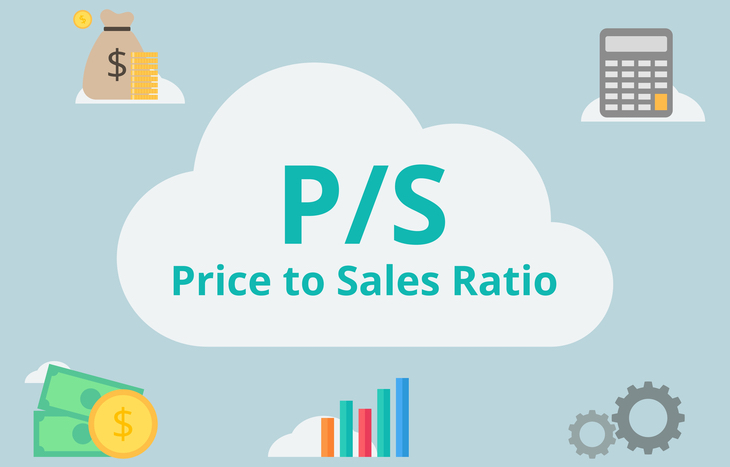What is Price-to-Sales (P/S) Ratio?
A company’s sales activity says a lot about its ability to succeed. And while profit margins and COGS offer a more accurate insight into just how efficient the company is, sales data is nevertheless important when considering demand for goods and services. It’s also instrumental for assessing a company’s price-to-sales (P/S) ratio: the ratio between the price of a company’s share and its sales per share.
Price-to-sales shows investor confidence in a company’s ability to sell its products or services. The P/S ratio is also known as a sales multiple or revenue multiple: the value investors place on every dollar of a company’s revenue generated. It’s a benchmarking metric that, when compared to competitors in the same industry, gives investors signals about how affordable or expensive the stock is.

How to Calculate Price-to-Sales Ratio
To calculate P/S ratio, you need to know the market capitalization of the company. To do this, take the number of outstanding shares and multiply it by the current share price. Once you know market capitalization, divide that by the company’s total sales revenue over the trailing 12 months.
For example, ABC Company has a market capitalization of $10 billion, with trailing 12-month sales of $5 billion. ABC Company’s P/S ratio is 2. This suggests that investors believe the value of the company is worth double its sales revenues—or, that every dollar the company makes is worth another $1 to investors.
What is a Good Price-to-Sales Ratio?
As is the case for most evaluation metrics, the price-to-sales ratio is best qualified in context. Context can include against direct competitors or companies within the same sector. A “good” price to sales ratio is one that’s lower than competitors.
Low P/S ratio indicates a stock that’s undervalued; high P/S ratio suggests the stock is overvalued. For example, if a company’s P/S ratio is 0.75 and the industry average is 1.15, it could be a value play based on its sales abilities. Conversely, if the P/S ratio is 1.35 against the same industry average, it suggests the stock is slightly overvalued against competitors.
How to Use P/S to Compare Companies
Price-to-sales is a great way to compare company performance—especially between unprofitable companies. If Company A has growing sales but a declining stock price, its P/S might be lower than Company B, which has stagnant sales but a rising stock price. Compare the P/B of both companies to the sector average and it can bring light on which company is a better value investment.
The key factor to look at when comparing companies is the numerator in the equation: market capitalization. Eager investors can drive up market cap, which offsets trailing sales in the equation. For example, if a company has a market cap of $10 billion and trailing sales of $5 billion, its P/S is 2. If investors drive the cost per share up and raise the company’s market cap to $15 billion, those same trailing sales give it a P/S of 3. Be mindful of market cap when comparing companies.
Price-to-Sales vs. Forward Price-to-Sales Ratio
Price-to-sales and forward price-to-sales ratios are slightly different in terms of the sales figures used. While P/S looks at sales figures from the trailing 12 months, forward P/S uses projected sales data for the upcoming year. Both metrics have specific roles when evaluating a company.
- P/S ratio uses concrete data about a company’s past sales to make a reasonable assumption about its current premium. It’s not forward-looking, which means it might not account for current initiatives by the company or future market conditions.
- Forward P/S ratio relies on projections, which are best-guess estimates of sales in the future. While they’re often accurate to a degree, they’re far from a guarantee. Using forward P/S as a benchmark subjects investors to a level of uncertainty about sales.
The choice to use P/S or forward P/S as an evaluation metric typically comes down to investor preference. Do you prefer to value a stock based on the sales figures it already generated or on expected sales revenues in the coming period?
The Drawbacks of P/S Ratio as a Metric
Price-to-sales isn’t a perfect metric and there are some important considerations investors need to be aware of when using it.
- P/S doesn’t account for profit (or lack thereof). It specifically looks at sales revenue.
- It likewise doesn’t account for profit margin, which varies widely across companies.
- And it isn’t a good benchmark for companies across different sectors, since sales vary.
- P/S is dependent on market cap, which could be artificially inflated at the moment.
Simply put, the price-to-sales ratio is a great metric for looking at a company’s ability to generate revenue. This assumes that revenue will translate into profit, which will result in value to shareholders. If, however, the company can’t turn sales into profits, P/S becomes a moot point.
The Value of a Company’s Revenue
Price-to-sales (P/S) ratio is a great measure of investor confidence in a company’s ability to generate revenue growth. Buying into a company’s strong history of sales indicates that investors believe they’ll continue to increase in the future—as will revenue. P/S ratio is a great way to value companies that may be growing but not yet profitable, or those growth hacking their way to a strong market share.
For the latest stock tips and insights, sign up for the Trade of the Day e-letter below. The experts at Trade of the Day do the research for you and provide stock picks that may enhance your portfolio!
When using P/S ratio as an evaluative tool, keep in mind that revenue and profit are very different. Look at sales figures in comparison to the company’s financials, and compare P/S to market competitors to gauge whether the stock’s value is low, high or on-par. Price-to-sales ratio is a great metric, but only when investors use it appropriately.





